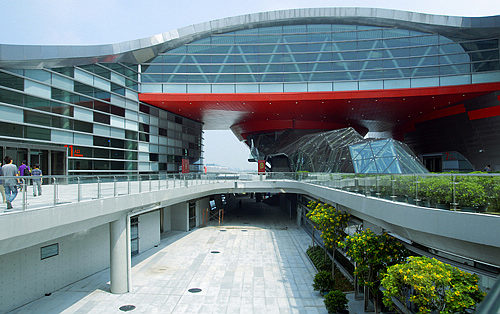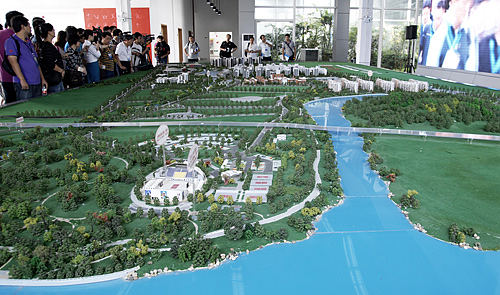|
 |
|
SELF CLEANING GYM: The streamlined roof of the Guangzhou Asian Games Town Gymnasium can collect rainwater and store it underground for later use (JING XIAOLEI) |
A walk inside the Guangzhou Asian Games Town, where the event's prized Asian Games Town Gymnasium, Athletes' Village and Media Village can be found, will have any visitor marveling at the structures and architectural styles within. But what's most impressive about this part of Guangzhou, Guangdong Province, is not what's in the town, but what's missing from it. Even the most observant visitor will be hard pressed to find a single garbage truck, or garbage can for that matter, inside the town's perimeter.
"That owes to the advanced vacuum waste treatment system, which is built underground. It's very efficient," said Fan Haoran, a manager in charge of residential services at the Athletes' Village.
Village residents can simply throw their waste into pipes installed in all the houses. The garbage is then sucked underground, transported to a central waste collection center and compressed into an airtight garbage can. Garbage trucks then transport the cans to the city's two waste disposal stations.
"The vacuum also helps to avoid secondary contamination," Fan said.
The new garbage system is just one component of the larger goal of making the Asian Games as green, low carbon and energy efficient as possible--another green innovation includes the comprehensive utilization of water.
Three water stations pump water from nearby rivers for use in the Asian Games Town, with part of the water used to provide chilled water for air conditioning units in the village. This helps save about 1 percent of air conditioning power consumption. In turn, the air conditioners produce hot water for showers and baths.
Additionally, the roof of the gymnasium functions as a rainwater collector that can store up to 1,000 cubic meters of water in three underground pools. The water will then be used to clean the various sports venues at the gymnasium.
The gymnasium also features other energy-saving techniques involving afforestation, lighting and solar energy. More so impressive is the structure's 60 percent energy-saving rate, which is higher than the 50 percent rate required for any public building in China.
 |
|
ONE WITH NATURE: Adjacent to the Lotus Mountain and Lotus Waterway, the Guangzhou Asian Games Town enjoys a stunningly beautiful ecological environment (JING XIAOLEI) |
Transportation inside the Asian Games Town is equally eco-friendly--bike rentals and electric car services will be available and most buildings are within walking distance of each other. Altogether, the games' transportation methods could reduce the dependence on motor vehicles from 80 percent to 30 percent.
Local architectural flavor
Designing buildings using the local Lingnan style was encouraged during the construction phase as Asian Games facilities. Lingnan-style architecture, widespread in Guangdong Province and Guangxi Zhuang Autonomous Region, is known for its gorgeous and articulate decorations, compact layout and design suitable for the region's humid climate.
Lingnan-style window designs maximize the use of natural light and airflow, and much of the traditional architecture is actually low carbon, said Vice Mayor of Guangzhou Xu Ruisheng, who is also the Executive Deputy Secretary General of the Guangzhou Asian Games Organizing Committee (GAGOC). "Venues built with these designs for the games can host daytime sports events without extra lighting."
Aside from its green motivations and not wanting to simply hire big-name foreign architects, GAGOC also wanted to give young local designers a stage to demonstrate their talent and creativity.
"We were happy to see Chinese architects, mostly educated and raised after China adopted its reform and open-up policies in the late 1970s, win out in our international biddings for venue design," Xu said. Design work for the Asian Games Town was a joint-project between China and the United States, but much of the work was done by Chinese architects in their 30s and 40s.
Adjacent to Lotus Mountain and Lotus Waterway and enjoying an exceptional ecological environment, GAGOC wants the Asian Games Town to be a natural splendor integrating man-made marvels with nature's waterway and the nearby mountain.
A scenic spot inside the Asian Games Town, including local-style buildings, gardens and a street featuring folk customs, could also be in the works to showcase the Lingnan flavor.
No Small Town
The 2.73 square km Guangzhou Asian Games Town consists of seven major areas: the Athletes' Village, the Technical Officials' Village, the Media Village, the Main Media Center, the Logistics Area, the Gymnasium and the Asian Games Park.
The Asian Games Town can accommodate the expected 40,000 athletes, coaches, technical officials and members of the media from around the world. | 